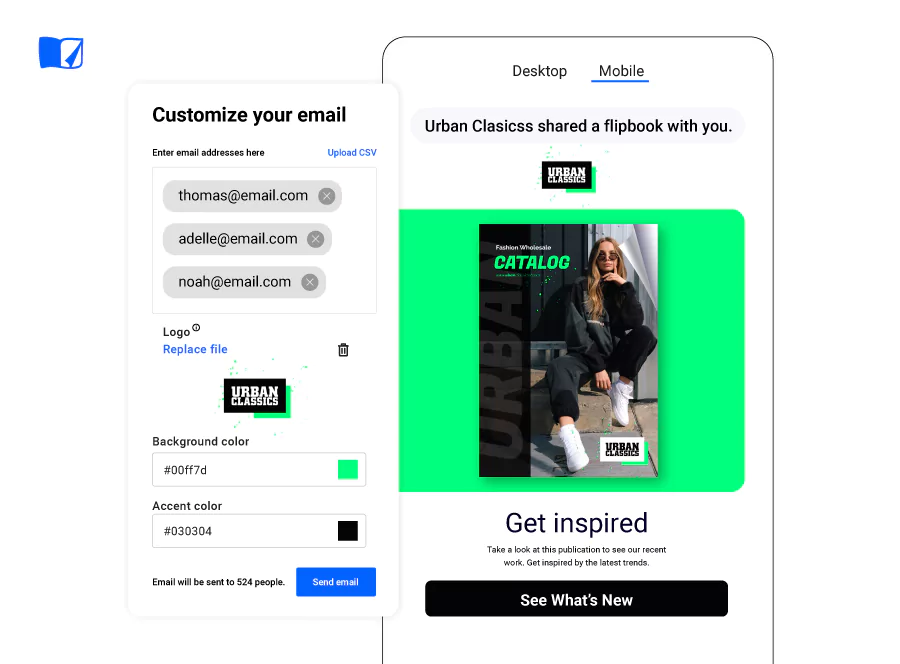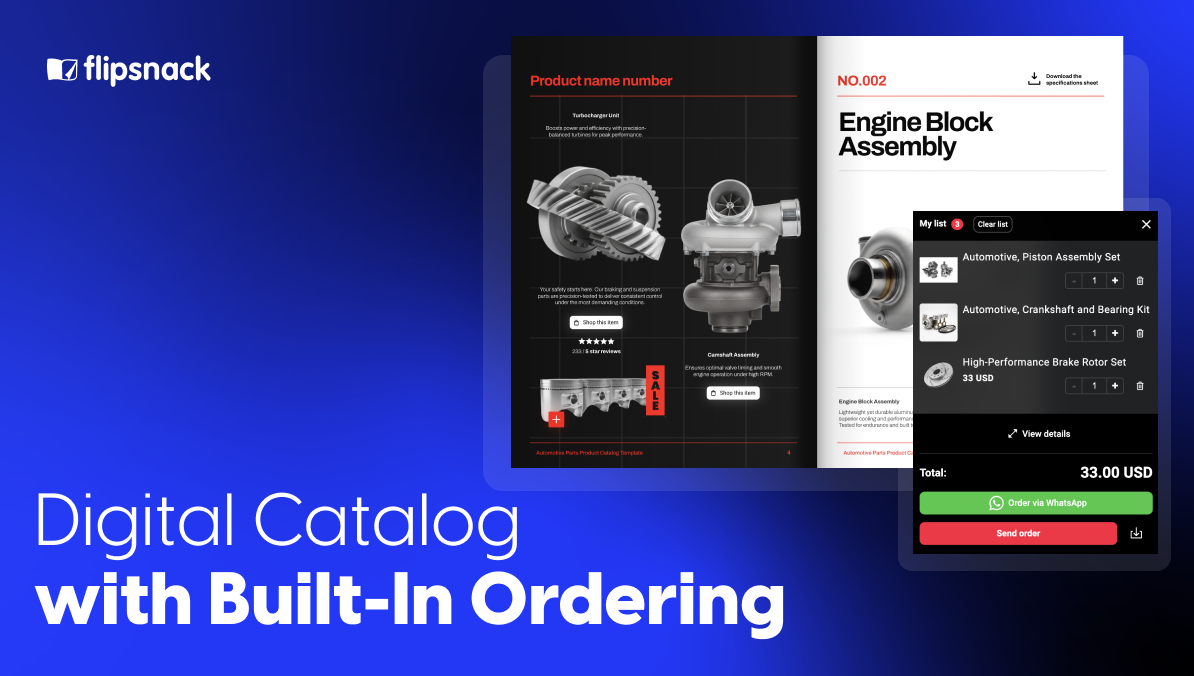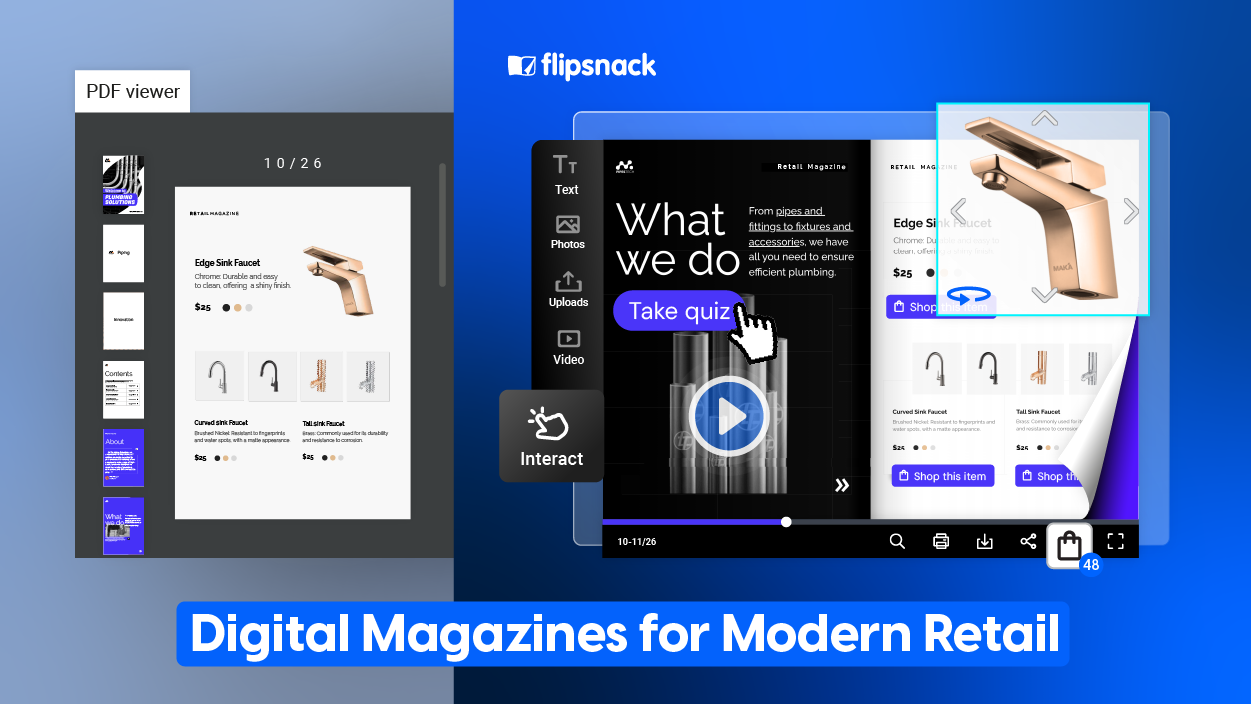How to Turn Emails Into Shopping Experiences with Digital Catalogs
Email is still one of the most effective ways to reach your customers. But if you’re still sending static PDF catalogs or plain links, you’re wasting that opportunity.
To turn opens into clicks and clicks into conversions, your emails need to lead somewhere engaging.
This is where digital catalogs become your most powerful tool.
By using your email as a gateway to a dynamic, interactive storefront, you create a seamless, trackable path from the inbox directly to a purchase.
This article shows you how to move past generic emails and leverage digital catalogs to shorten the sales cycle, stay relevant, and make data-driven decisions.
Table of contents
- Benefits of product catalog emails
- How to make your catalog email strategy work
- Why Flipsnack makes your product catalog email strategy simple and trackable
- Customer spotlight: how Chez Pluie doubled subscribers and boosted revenue with Flipsnack
- Bridge the gap between email and shoppable digital catalogs with Flipsnack
- Final thoughts
Benefits of product catalog emails
Email marketing is only effective if it leads somewhere. Sending people to a clunky landing page or attaching a static PDF doesn’t cut it anymore. Digital catalogs fix that.
They create a path from inbox to product page and that changes the game in many ways:
1. A direct line from browsing to buying
The fewer steps between interest and purchase, the better. Embedding a catalog link in your email means subscribers can browse and shop without friction. You can use your interactive catalog to add product links, and even in-catalog checkout options.
2. Always up to date
Forget reprints and outdated PDFs. With digital catalogs, you can update prices, swap out products, or change promotions in real time even after hitting send. That flexibility keeps your email campaigns relevant and useful, even weeks after delivery.
3. Built for every screen
With the right provider, modern digital catalogs are mobile-optimized. Whether someone opens your email on a phone or desktop, the catalog adapts to their screen.
4. Tell a better brand story
An interactive catalog is a space where design, layout, and interactivity come together to reflect your brand’s personality. You can build emotion, guide people through a journey, and leave a stronger impression than any plain-text email ever could.
5. Cost-effective and sustainable
Digital catalogs are cheaper to produce and better for the environment. Plus, as previously mentioned, they’re easier to send, update, forward, and reuse in future campaigns.

How to make your catalog email strategy work
If you want people to open your email, explore your catalog, and take action, every part of your message needs to be intentional.
Here’s how to get your catalog email strategy right:
1. Start with an email people want to open
The subject line is your first (and often only) chance. Make it useful, not vague. Hint at what’s inside or call out the value directly. Once they’re in, don’t waste time. Use a short, clear intro to explain what the catalog is and why it’s worth their attention.
Keep your layout clean, mobile-friendly, and focused on a single action. If your call to action is buried, your catalog won’t get any attention.
💡 If you need inspiration for subject lines that drive opens, you can check out these examples of really good emails.
2. Make it relevant to the reader
Catalogs work best when they’re not generic. That means segmenting your list and matching the message to the audience. A wholesale customer doesn’t want the same catalog as a casual shopper.
Someone who bought last month isn’t looking for the same thing as someone who abandoned their cart. Use what you know (past behavior, customer type, even location) to send better emails.
💡Creating tailored catalogs for different audiences sounds time-consuming. And it is, if you’re doing it manually. But with the right automation tools, you can generate entire catalogs faster and at scale without sacrificing relevance or quality.
3. Don’t hide the catalog—show it
Too many emails drop a bland link and hope for clicks. That doesn’t work. Use a strong visual anchor. Show the cover of your catalog and give the reader a reason to engage by setting expectations with a short caption or headline. For example, “Preview our fall collection” works better than “Click here.”
4. Track what works and use the data
Start by monitoring open rates. If people aren’t opening your emails, the catalog won’t get noticed. Look at subject line performance, audience segments, and send times to understand what gets attention. Patterns will show up quickly once you start comparing results over time.
After the open, engagement inside the catalog is your next focus. See how long readers stay, which pages they view, and where they lose interest. If they drop off early, that’s a sign your content isn’t pulling them in. If certain pages get more attention, prioritize that content next time.
Why Flipsnack makes your product catalog email strategy simple and trackable
If you’re serious about making email + catalog work, Flipsnack removes the roadblocks:
Creation & interactivity
You can upload a PDF and transform it into an interactive digital catalog. The platform also gives you the ability to design a catalog from scratch or use a pre-made template, and then easily add shopping links, videos, contact forms, and other interactive elements. This means you’re not just sending a document; you’re creating an experience that’s built to drive action.
Automated updates
The real-time automation feature is a game-changer. By connecting your product data from a CSV, XLSX file, or Google Sheet, Flipsnack can automatically populate your catalogs and keep them up-to-date. This eliminates the manual, tedious work of updating prices, descriptions, and images, ensuring your catalogs are always accurate even after they’ve been sent.
Email integration
Flipsnack provides a direct, shareable link for your catalog, which is perfect for email. Instead of a bulky, static PDF, you can send a clean, branded link that opens to a professional, mobile-friendly catalog. You can even generate different catalog versions for specific audiences, so your email campaigns feel personal and relevant. Before sending out your branded catalogs, run a quick DMARC record check to ensure your domain is properly authenticated and protected against spoofing.
Branded emails
With Flipsnack’s Business plan and up, you don’t need to rely on third-party platforms to send on-brand emails. You can send your email catalogs directly to your audience, and every part of the message can reflect your brand.
You can upload your company logo, adjust background and accent colors to match your brand palette, and customize the subject line, header, and description. Even the email footer can be tailored to include your company details, links, or legal info.
Once you’ve set it up, you can save your design and reuse it. This helps you keep your emails consistent and recognizable every time.
If you’re on an Enterprise plan, you get even more control. You can route emails through your own AWS or Mailgun account, which means full ownership of delivery, reputation, and sender identity.
You can even replace the default noreply@flipsnack sender with your own custom domain for a more professional look.
And you’re not limited to email. The same digital catalog can be shared on social media, embedded on your site, or linked in newsletters—no need to rebuild your content for each channel.

Actionable analytics
Knowing who opened your email is helpful. But knowing what they did once they opened your digital catalog? That’s where things get interesting.
Flipsnack gives you a full set of metrics so you can understand how your catalog performs, page by page and product by product. Here’s what you can track:
- Impressions: Tracked every time your catalog is loaded.
- Views: Counted when someone actively interacts with your catalog.
- Average time spent: Tells you how long readers are actually engaging.
- Downloads: Shows how many times the catalog was saved as a PDF.
- Engagement stats: Measures clicks on interactive elements like buttons, links, or videos.
- Devices and traffic sources: See what platforms readers use and where they came from.
- Top locations: A map view of where your readers are, by country.
- Lead form performance: Track form submissions, export leads, and plug them into your CRM.
Form responses: Review answers from quizzes, surveys, or contact forms—all in one place.
Since we’re talking about product catalogs, you also get access to sales-focused metrics:
- Orders: Total number of orders placed through the catalog.
Popular products: See which products people interact with most often.
This level of insight helps you spot which catalogs and products perform best, so you can improve future campaigns, rework underperforming layouts, or create follow up emails based on specific reader behavior.
Customer spotlight: how Chez Pluie doubled subscribers and boosted revenue with Flipsnack
Chez Pluie, a French boutique specializing in curated antiques, needed a way to present its collection with more depth than a basic website or online store could offer. Beautiful pieces were reduced to flat listings, and engagement was low. Visitors spent just two minutes on the website, and the team struggled to replicate the in-person charm of browsing antiques.
Flipsnack helped them change that.
By building immersive, interactive digital catalogs, Chez Pluie gave customers a reason to stay longer and explore. Visitors spent an average of 9 minutes per catalog—a 350% increase in engagement. One catalog in particular, created to showcase a collection for cookbook author Patricia Wells, helped land them a feature in the New York Times.
That visibility translated into real business results:
- 9 minutes average time per catalog (compared to 2 minutes on the website)
- Doubled their newsletter subscribers in the first month
- 50% of monthly revenue came directly from the catalog
- Featured in the New York Times, boosting brand visibility
Founder Hugh Cameron summed it up clearly:
“It’s a revenue-generating tool, which is, for us, way more valuable than a cost-saving tool.”

Bridge the gap between email and shoppable digital catalogs with Flipsnack
Digital catalogs turn your email from a static message into an interactive storefront, but Flipsnack takes this a step further by bridging the final gap to a sale. It moves your readers from Browse to buying with a direct, friction-free path that’s impossible with a simple PDF.
Instead of sending customers to a separate website or making them search for products on their own, Flipsnack’s shoppable catalogs enable a direct line from your email to a purchasing experience.
Final thoughts
A good shopping experience starts with the first click. If your email only delivers a static PDF or a generic link, you’re not giving your customers much to engage with. But an email catalog changes that. It turns your message into something people can browse, interact with, and buy from—all without leaving the catalog.
Flipsnack helps you make that experience smooth, fast, and trackable. From personalized product content to branded emails and real-time insights, you have everything you need to move readers from inbox to checkout with less friction.
If you want to turn catalogs into conversions, this is the way to do it.




